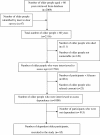Cost and burden of informal caregiving of dependent older people in a rural Indian community
- PMID: 24886051
- PMCID: PMC4022434
- DOI: 10.1186/1472-6963-14-207
Cost and burden of informal caregiving of dependent older people in a rural Indian community
Abstract
Background: Lack of state supported care services begets the informal caregiving by family members as the mainstay of care provided to the dependent older people in many Low and Middle Income Countries (LMICs), including India. Little is known about the time spent on caregiving, its cost and the burden experienced by these informal caregivers. We aimed to estimate the costs of informal caregiving and to evaluate the nature as well as correlates of caregivers' burden in a rural Indian community.
Methods: We assessed 1000 people aged above 65 years, among whom 85 were dependent. We assessed their socioeconomic profiles, disability, health status and health expenditures. Their caregivers' socio-demographic profiles, mental health, and the time spent on caregiving were assessed using standard instruments. Caregiver's burden was evaluated using Zarit Burden Scale. We valued the annual informal caregiving costs using proxy good method. We employed appropriate non-parametric multivariate statistics to evaluate the correlates of caregivers' burden.
Results: Average time spent on informal caregiving was 38.6 (95% CI 35.3-41.9) hours/week. Estimated annual cost of informal caregiving using proxy good method was 119,210 US$ in this rural community. Mean total score of Zarit burden scale, measuring caregivers' burden, was 17.9 (95% CI 15.6-20.2). Prevalence of depression among the caregivers was 10.6% (95% CI 4.1-17.1%). Cerebrovascular disease, Parkinson's disease, higher disability, insomnia and incontinence of the dependent older people as well as the time spent on helping Activities of Daily Living and on supervision increased caregiver's burden significantly.
Conclusions: Cost and burden of informal caregiving are high in this rural Indian community. Many correlates of burden, experienced by caregivers, are modifiable. We discuss potential strategies to reduce this burden in LMICs. Need for support to informal caregivers and for management of dependent older people with chronic disabling diseases by multidisciplinary community teams are highlighted.
Figures
Similar articles
-
The determinants of informal caregivers' burden in the care of frail older persons: a dynamic and role-related perspective.Aging Ment Health. 2017 Aug;21(8):838-843. doi: 10.1080/13607863.2016.1168360. Epub 2016 Apr 7. Aging Ment Health. 2017. PMID: 27054404
-
Geographical location as a determinant of caregiver burden: a rural-urban analysis of the informal caregiving, health, and healthcare survey in Ghana.BMC Prim Care. 2024 Aug 28;25(1):317. doi: 10.1186/s12875-024-02562-7. BMC Prim Care. 2024. PMID: 39198724 Free PMC article.
-
Social support, positive caregiving experience, and caregiver burden in informal caregivers of older adults with dementia.Front Public Health. 2023 Jan 25;11:1104250. doi: 10.3389/fpubh.2023.1104250. eCollection 2023. Front Public Health. 2023. PMID: 36761127 Free PMC article.
-
[Caregiver burden in relatives of persons with schizophrenia: an overview of measure instruments].Encephale. 2003 Mar-Apr;29(2):137-47. Encephale. 2003. PMID: 14567165 Review. French.
-
Projected Costs of Informal Caregiving for Cardiovascular Disease: 2015 to 2035: A Policy Statement From the American Heart Association.Circulation. 2018 May 8;137(19):e558-e577. doi: 10.1161/CIR.0000000000000570. Epub 2018 Apr 9. Circulation. 2018. PMID: 29632217 Review.
Cited by
-
Factors Impacting Quality of Life of Caregivers of Cancer Patients in the Sub-Himalayan Region: A Cross-Sectional Study.Cureus. 2023 Feb 19;15(2):e35168. doi: 10.7759/cureus.35168. eCollection 2023 Feb. Cureus. 2023. PMID: 36949997 Free PMC article.
-
Willingness-to-pay and willingness-to-accept of informal caregivers of dependent elderly people in Shanghai, China.BMC Health Serv Res. 2020 Jul 6;20(1):618. doi: 10.1186/s12913-020-05481-2. BMC Health Serv Res. 2020. PMID: 32631341 Free PMC article.
-
In Caring for Older People in Low- and Middle-Income Countries, Do Older Caregivers Have a High Level of Care Burden and Psychological Morbidity Compared to Younger Caregivers?Int J Environ Res Public Health. 2022 Dec 7;19(24):16405. doi: 10.3390/ijerph192416405. Int J Environ Res Public Health. 2022. PMID: 36554286 Free PMC article.
-
Understanding the use of Flexible Work Arrangements Among Older New Zealand Caregivers.J Appl Gerontol. 2023 May;42(5):1045-1055. doi: 10.1177/07334648231152153. Epub 2023 Jan 14. J Appl Gerontol. 2023. PMID: 36639985 Free PMC article.
-
The experience of informal caregiving within Saudi society: expressed needs and expectations.J Egypt Public Health Assoc. 2023 Feb 15;98(1):2. doi: 10.1186/s42506-023-00130-y. J Egypt Public Health Assoc. 2023. PMID: 36788162 Free PMC article.
References
-
- UNICEF. Empower Women to Help Children. 2007. http://www.unicef.org/media/media_37474.html.
-
- UN. Development in an Ageing World. 2007. http://www.un.org/en/development/desa/policy/wess/wess_archive/2007wess.pdf.
-
- UN. Population Ageing and Development 2012. 2012. http://www.un.org/esa/population/publications/2012WorldPopAgeingDev_Char....
Publication types
MeSH terms
LinkOut - more resources
Full Text Sources
Other Literature Sources
Medical


